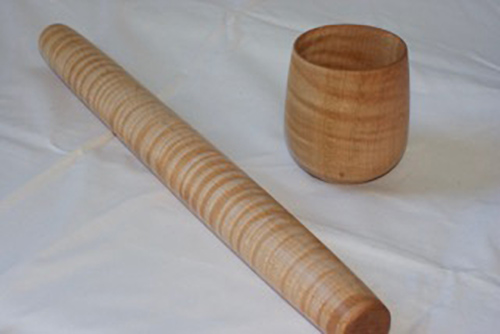
Beautiful Tiger Maple French Rolling Pin and Cup
It has been my policy not to buy wood but work with wood people give me. However, tiger maple does not come my way by this route. I am so fond of it that I broke down and bought some. At my last show a wood salesman whom I have met before was trolling all the woodworking booths to tell that his boss had just recently put on sale some exceptional tiger maple that he had been holding back for years. I took the bait and the next day I went to visit the lumber yard and true to his promise the wood was exceptional. Above pictured is a French style rolling pin which is sixteen inches in length as well as a cup from the same wood.
I have been turning wood for many years but never have I seen such beautiful tiger maple. The wood appears to have light and dark bands but they are just an optical illusion. Normally wood cells grow straight but in tiger maple they grow in a spiral pattern. When light hits the wood cells which are growing at different angles the light is reflected differently. Some places it adds with other waves and in others it subtracts to give the appearance of light and dark bands. Yet you can prove to yourself that the light and dark areas are not in the wood since they appear to move as you tilt the wood up and down in the light. This phenomenon is called chatoyance. This is a term lifted from the French language that means it looks like the eye of a cat. Cat’s eye is a semi-precious stone which displays this same shifting of light depending on the angle from which it is viewed.
You can see chatoyance in any wood where the wood cells don’t grow in a parallel fashion. Often around stumps where the wood has buckled with pressure from the tree or in areas where a limb joins the trunk and gravity has applied lots of pressure to the wood cells you will see chatoyance. However it is localized. In tiger maple all the wood displays chatoyance. It must be a genetic variation in the tree. I find this optical effect most charming and feel fortunate to have sound such a classic example of this in the maple pictured above.
Some people collect rolling pins and this one is certainly worthy of any collection. Yet it is a completely practical tool that will last for generations if cared for properly. Think how uplifted the cook feels when they pick up this beautiful piece of wood.
